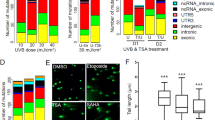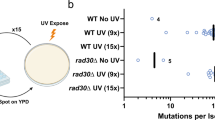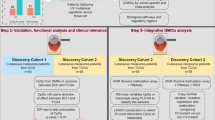Abstract
Ultraviolet radiation (UVR) exposure increases malignant melanoma (MM) risk, but in the context of acute, not cumulative exposure. C>T and CC>TT changes make up the overwhelming majority of single base substitutions (SBS) in MM DNA, as both precursor melanocytes and melanocytic lesions have incurred incidental exposures to sunlight. To study the mutagenic mechanisms by which acute sunburn accelerates MM, we sequenced the exomes of spontaneous and neonatal UVB-induced Cdk4-R24C::Tyr-NRASQ61K mouse MMs. UVR-induced MMs carried more SBSs than spontaneous MMs, but the levels of genomic instability, reflected by translocations and copy number changes, were not different. C>T/G>A was the most common SBS in spontaneous and UVR-induced MMs, only modestly increased in the latter. However, they tended to occur at the motif A/GpCpG (reflecting C>T transition due to spontaneous deamination of cytosine at CpG) in spontaneous MMs, and T/CpCpC/T (reflecting the effects of pyrimidine dimers on either side of the mutated C) in UVR-induced MMs. Unlike MMs associated with repetitive exposures, we observed no CC>TT changes. In addition, we also found UVR ‘footprints’ at T>A/A>Ts (at NpTpT) and T>C/A>G (at CpTpC). These footprints are also present in MMs from a chronic UVR mouse model, and in some human MMs, suggesting that they may be minor UVR signature changes. We found few significantly somatically mutated genes (~6 per spontaneous and 15 per UVR-induced melanoma) in addition to the Cdk4 and NRAS mutations already present. Trp53 was the most convincing recurrently mutated gene; however, in the UVR-induced MMs no Trp53 mutations were at C>T/G>A, suggesting that it was probably mutated during tumour progression, not directly induced by UVR photoproducts. The very low load of recurrent mutations convincingly induced by classical UVB-induced dimer photoproducts may support a role for cell extrinsic mechanisms, such as photoimmunosuppression and inflammation in driving MM after acute UVB exposure.
This is a preview of subscription content, access via your institution
Access options
Subscribe to this journal
Receive 50 print issues and online access
$259.00 per year
only $5.18 per issue
Buy this article
- Purchase on Springer Link
- Instant access to full article PDF
Prices may be subject to local taxes which are calculated during checkout



Similar content being viewed by others
References
Gandini S, Sera F, Cattaruzza MS, Pasquini P, Picconi O, Boyle P et al. Meta-analysis of risk factors for cutaneous melanoma: II. Sun exposure. Eur J Cancer 2005; 41: 45–60.
Pfeifer GP, You YH, Besaratinia A . Mutations induced by ultraviolet light. Mutat Res 2005; 571: 19–31.
Brash DE . UV Signature Mutations. Photochem Photobiol 2015; 91: 15–26.
Hodis E, Watson IR, Kryukov GV, Arold ST, Imielinski M, Theurillat JP et al. A landscape of driver mutations in melanoma. Cell 2012; 150: 251–263.
Krauthammer M, Kong Y, Ha BH, Evans P, Bacchiocchi A, McCusker JP et al. Exome sequencing identifies recurrent somatic RAC1 mutations in melanoma. Nat Genet 2012; 44: 1006–1014.
Furney SJ, Turajlic S, Fenwick K, Lambros MB, MacKay A, Ricken G et al. Genome sequencing of mucosal melanomas reveals that they are driven by distinct mechanisms from cutaneous melanoma. J Pathol 2013; 230: 261–269.
Nakazawa H, English D, Randell PL, Nakazawa K, Martel N, Armstrong BK et al. UV and skin cancer: specific p53 gene mutation in normal skin as a biologically relevant exposure measurement. Proc Natl Acad Sci USA 1994; 91: 360–364.
Ouhtit A, Nakazawa H, Armstrong BK, Kricker A, Tan E, Yamasaki H et al. UV-radiation-specific p53 mutation frequency in normal skin as a predictor of risk of basal cell carcinoma. J Natl Cancer Inst 1998; 90: 523–531.
Martincorena I, Roshan A, Gerstung M, Ellis P, Van Loo P, McLaren S et al. Tumor evolution. High burden and pervasive positive selection of somatic mutations in normal human skin. Science 2015; 348: 880–886.
Sheppard KE, McArthur GA . The cell-cycle regulator CDK4: an emerging therapeutic target in melanoma. Clin Cancer Res 2013; 19: 5320–5328.
Ferguson B, Ram R, Handoko HY, Mukhopadhyay P, Muller HK, Soyer HP et al. Melanoma susceptibility as a complex trait: genetic variation controls all stages of tumor progression. Oncogene 2014; 34: 2879–2886.
Lawrence MS, Stojanov P, Polak P, Kryukov GV, Cibulskis K, Sivachenko A et al. Mutational heterogeneity in cancer and the search for new cancer-associated genes. Nature 2013; 499: 214–218.
Viros A, Sanchez-Laorden B, Pedersen M, Furney SJ, Rae J, Hogan K et al. Ultraviolet radiation accelerates BRAF-driven melanomagenesis by targeting TP53. Nature 2014; 511: 478–482.
Metz CH, Scheulen M, Bornfeld N, Lohmann D, Zeschnigk M . Ultradeep sequencing detects GNAQ and GNA11 mutations in cell-free DNA from plasma of patients with uveal melanoma. Cancer Med 2013; 2: 208–215.
Wu H, Goel V, Haluska FG . PTEN signaling pathways in melanoma. Oncogene 2003; 22: 3113–3122.
Matin RN, Chikh A, Chong SL, Mesher D, Graf M, Sanza' P et al. p63 is an alternative p53 repressor in melanoma that confers chemoresistance and a poor prognosis. J Exp Med 2013; 210: 581–603.
Zaidi MR, Davis S, Noonan FP, Graff-Cherry C, Hawley TS, Walker RL et al. Interferon-γ links ultraviolet radiation to melanomagenesis in mice. Nature 2011; 469: 548–553.
Wolnicka-Glubisz A, Noonan FP . Neonatal susceptibility to UV induced cutaneous malignant melanoma in a mouse model. Photochem Photobiol Sci 2006; 5: 254–260.
Cancer Genome Atlas Network. Genomic Classification of Cutaneous Melanoma. Cell 2015; 161: 1681–1696.
Ikehata H, Ono T . The mechanisms of UV mutagenesis. J Radiat Res 2011; 52: 115–125.
Besaratinia A, Synold TW, Xi B, Pfeifer GP . G-to-T transversions and small tandem base deletions are the hallmark of mutations induced by ultraviolet a radiation in mammalian cells. Biochemistry 2004; 43: 8169–8177.
Robert C, Muel B, Benoit A, Dubertret L, Sarasin A, Stary A . Cell survival and shuttle vector mutagenesis induced by ultraviolet A and ultraviolet B radiation in a human cell line. J Invest Dermatol 1996; 106: 721–728.
Besaratinia A, Kim SI, Pfeifer GP . Rapid repair of UVA-induced oxidized purines and persistence of UVB-induced dipyrimidine lesions determine the mutagenicity of sunlight in mouse cells. FASEB J 2008; 22: 2379–2392.
Otoshi E, Otoshi E, Yagi T, Mori T, Matsunaga T, Nikaido O et al. Respective roles of cyclobutane pyrimidine dimers, (6-4)photoproducts, and minor photoproducts in ultraviolet mutagenesis of repair-deficient xeroderma pigmentosum A cells. Cancer Res 2000; 60: 1729–1735.
Bryan DS, Ransom M, Adane B, York K, Hesselberth JR . High resolution mapping of modified DNA nucleobases using excision repair enzymes. Genome Res 2014; 24: 1534–1542.
Su DG, Taylor JS, Gross ML . A new photoproduct of 5-methylcytosine and adenine characterized by high-performance liquid chromatography and mass spectrometry. Chem Res Toxicol 2010; 23: 474–479.
Giglia-Mari G, Sarasin A . TP53 mutation in human skin cancers. Hum Mutat 2003; 21: 217.
Jia P, Pao W, Zhao Z . Patterns and processes of somatic mutations in nine major cancers. BMC Med Genomics 2014; 7: 11.
Ikehata H, Higashi S, Nakamura S, Daigaku Y, Furusawa Y, Kamei Y et al. Action spectrum analysis of UVR genotoxicity for skin: the border wavelengths between UVA and UVB can bring serious mutation loads to skin. J Invest Dermatol 2013; 133: 1850–1856.
Mitchell DL, Paniker L, Douki T . DNA damage, repair and photoadaptation in a Xiphophorus fish hybrid. Photochem Photobiol 2009; 85: 1384–1390.
Pattison DI, Davies MJ . Actions of ultraviolet light on cellular structures. EXS 2006; 96: 131–157.
Mitchell DL, Nairn RS . The biology of the (6-4) photoproduct. Photochem Photobiol 1989; 49: 805–819.
Jans J, Garinis GA, Schul W, van Oudenaren A, Moorhouse M, Smid M et al. Differential role of basal keratinocytes in UV-induced immunosuppression and skin cancer. Mol Cell Biol 2006; 26: 8515–8526.
Ravanat JL, Douki T, Cadet J . Direct and indirect effects of UV radiation on DNA and its components. J Photochem Photobiol B 2001; 63: 88–102.
Song Q, Cannistraro VJ, Taylor JS . Synergistic modulation of cyclobutane pyrimidine dimer photoproduct formation and deamination at a TmCG site over a full helical DNA turn in a nucleosome core particle. Nucleic Acids Res 2014; 42: 13122–13133.
Malcikova J, Smardova J, Rocnova L, Tichy B, Kuglik P, Vranova V et al. Monoallelic and biallelic inactivation of TP53 gene in chronic lymphocytic leukemia: selection, impact on survival, and response to DNA damage. Blood 2009; 114: 5307–5314.
Selvanayagam CS, Davis CM, Cornforth MN, Ullrich RL . Latent expression of p53 mutations and radiation-induced mammary cancer. Cancer Res 1995; 55: 3310–3317.
Carsten MJ, Krempler A, Triplett AA, Van Lohuizen M, Wagner KU . Cell cycle arrest and cell death are controlled by p53-dependent and p53-independent mechanisms in Tsg101-deficient cells. J Biol Chem 2004; 279: 35984–35994.
Slovackova J, Grochova D, Navratilova J, Smarda J, Smardova J . Transactivation by temperature-dependent p53 mutants in yeast and human cells. Cell Cycle 2010; 9: 2141–2148.
Fulci G, Ishii N, Maurici D, Gernert KM, Hainaut P, Kaur B et al. Initiation of human astrocytoma by clonal evolution of cells with progressive loss of p53 functions in a patient with a 283H TP53 germ-line mutation: evidence for a precursor lesion. Cancer Res 2002; 62: 2897–2905.
Alexandrov LB, Nik-Zainal S, Wedge DC, Campbell PJ, Stratton MR . Deciphering signatures of mutational processes operative in human cancer. Cell Rep 2013; 3: 246–259.
Acknowledgements
This work was supported by The Cancer Council of Queensland, and the National Health and Medical Research Council of Australia. We thank Nick Hayward and Peter Johansson for helpful discussions, and Grant Morahan for prompting us to consider the influence of genetic background on cancer incidence.
Author information
Authors and Affiliations
Corresponding author
Ethics declarations
Competing interests
The authors declare no conflict of interest.
Additional information
Supplementary Information accompanies this paper on the Oncogene website
Supplementary information
Rights and permissions
About this article
Cite this article
Mukhopadhyay, P., Ferguson, B., Muller, H. et al. Murine melanomas accelerated by a single UVR exposure carry photoproduct footprints but lack UV signature C>T mutations in critical genes. Oncogene 35, 3342–3350 (2016). https://doi.org/10.1038/onc.2015.386
Received:
Revised:
Accepted:
Published:
Issue Date:
DOI: https://doi.org/10.1038/onc.2015.386
This article is cited by
-
Exome sequencing identifies novel mutation signatures of UV radiation and trichostatin A in primary human keratinocytes
Scientific Reports (2020)
-
Melanocyte transformation requires complete loss of all pocket protein function via a mechanism that mitigates the need for MAPK pathway activation
Oncogene (2017)



